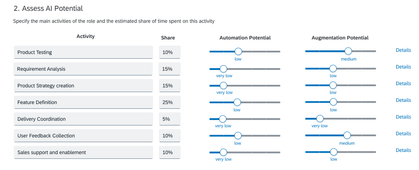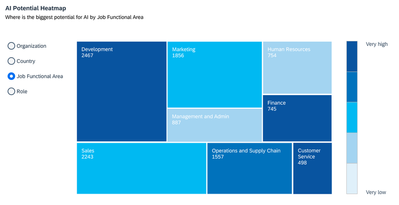
- SAP Community
- Groups
- Interest Groups
- Career Corner
- Blog Posts
- Identifying the AI Potential in Your Organization:...
- Subscribe to RSS Feed
- Mark as New
- Mark as Read
- Bookmark
- Subscribe
- Printer Friendly Page
- Report Inappropriate Content
In an era where artificial intelligence (AI) is rapidly transforming the workplace, businesses are eager to harness its potential. However, cutting through the hype to understand where AI can truly make a difference remains a challenge for many.
The allure of 'Shiny Object Syndrome,' fueled by the ambitious promises of AI solution vendors, often leads companies to prematurely leap into technology implementation. This rush overlooks an important preliminary step – a systematic evaluation of where AI can truly deliver transformative value within an organization.
This article describes a strategic approach to quantify the potential of AI in your organization and helps to identify opportunities for automating and augmenting work activities.
Approach
Using traditional methods, executing an organization-wide assessment to identify potential areas for AI application is a daunting and time-intensive task. However, by leveraging Generative AI, this assessment can be done in a much more efficient way. Based on a first draft created by generative AI, organizations can quickly gain an initial overview, setting the stage for a deeper exploration of roles and specific use cases.
A critical prerequisite for this AI-driven assessment is the clear definition and documentation of roles within the organization, accurately reflected in the workforce data. Providing those roles as an input, a series of prompts to a Large Language Model like GPT4 can deconstruct roles into activities and assess the automation and augmentation potential.
The approach consists of the following main steps:
1. Decomposing Roles
Breaking down each role into its main activities and the respective time shares.
The cornerstone of understanding AI's potential impact on your workforce begins with a detailed decomposition of each role into its main activities, alongside an analysis of the time allocation for each. It's essential to recognize that AI's influence is not on the roles per se, but rather on the specific activities that these roles encompass.
While Generative AI technologies, such as GPT-4, are adept at providing well-informed estimations for a wide range of common roles, the involvement of internal experts in this step cannot be overstated. Their domain-specific knowledge and understanding of the nuances of each role within your organization are essential. By reviewing and fine-tuning the AI-generated breakdowns, these experts can significantly enhance the accuracy and are crucial to get acceptance for the results.
2. AI Potential Assessment
Estimating the AI potential on the activity level.
With a clear understanding of the core activities constituting each role, the next step is to evaluate the potential impact of AI on these activities. This assessment differentiates between two key dimensions of AI application: automation and augmentation.
Automation refers to instances where AI can assume responsibility for a task, either in part or in its entirety. Full automation means AI can operate independently, reducing or eliminating the need for human intervention in specific activities.
Augmentation, on the other hand, focuses on how AI can supplement human efforts, enhancing overall productivity. In this scenario, AI tools assist by handling monotonous tasks or providing valuable insights, thereby empowering humans to maintain decision-making authority while benefiting from AI's capabilities.

For each activity, the Large Language Model (LLM) not only provides a rating of the potential for automation and augmentation but also provides the reasoning behind these assessments. This layer of insight serves as an excellent foundation for in-depth discussions and further refinement with domain experts.
Automating and repeating this process for all relevant roles in the organization will result in a comprehensive database detailing the AI potential for each role within your organization.
3. Expert Validation
Cross-verify the generative AI's findings with domain experts.
Following the preliminary AI-driven assessment, the next step involves a cross-verification of these findings with domain experts. This step is pivotal in transitioning from broad, AI-generated insights to precise, organization-specific evaluations tailored to the unique context of your business.
This expert validation serves a dual purpose. Firstly, it enhances the reliability and relevance of the assessment data, grounding AI's theoretical potential in the realities of day-to-day operations. Secondly, involving experts in this validation process fosters a sense of ownership and alignment with the assessment outcomes.
While this thorough validation process may not be immediately necessary for every role within the organization, it becomes crucial as the assessment data starts informing strategic decisions. Prior to leveraging this data to prioritize AI use cases, allocate resources, or initiate other significant actions, a comprehensive expert review ensures that the foundation for these decisions is both solid and strategically sound.
4.Identifying High-Value Areas
Creating an overview where AI can significantly enhance workforce productivity.
With a comprehensive dataset spanning multiple roles at hand, it is possible to map out a big picture of AI opportunities within the organization. This process step is about synthesizing the AI assessment results with key organizational metrics - such as FTE, organizational structures, and personnel cost - to contextualize the AI potential.
The combined data allows many different analytical views, here are three examples:
AI Potential by Job Area
| This type of visualization can act as the high-level overview of where the potential of leveraging might be high vs. low and how many employees could be impacted. |  |
AI Potential by role
Distinguishing between the potential for automation and augmentation at the level of individual roles provides a more nuanced and actionable understanding of how AI can be effectively leveraged within the organization.
AI Potential by Activity

This graph serves as a activity level overview where AI can be most beneficial across the organization. The vertical axis of the chart quantifies the overall potential impact of AI, while the horizontal axis reflects the associated value or cost of each activity. Activities represented by bubbles located higher and to the right on the chart are identified as having a higher potential for AI-driven improvements.
To ensure a comprehensive analysis, this evaluation can be conducted from a broad organizational standpoint or broken down by specific business units, job functions, and other relevant criteria.
5. Use Case Development:
Exploring specific AI applications to capitalize on identified potential.
The assessment's outcomes can not only help to identify high value area for implementing AI but also as a standardized framework for evaluating the workforce related business case of AI initiatives.
Understanding the value attributed to various activities and the effort invested in them enables a prioritized approach to deploying AI solutions where they can make the most significant impact. Moreover, the detailed inventory of roles, associated activities, and the corresponding workforce data provides a uniform set of metrics to calculate business cases . This consistency is invaluable for accurately estimating and comparing the potential returns of diverse AI use cases, ensuring a coherent and strategic application of AI technologies across the organization.
Summary
Leveraging Generative AI to assess the AI Potential in a workforce helps businesses go beyond just talking about how AI might change jobs. It uses the specific roles and workforce information of an organization to give a clearer picture of where AI can really make a difference. While the initial results from using generative AI are quite promising, especially for common job roles, they should be seen as just the beginning, a solid base for deeper exploration.
It's also crucial to remember that work involves complex, interconnected tasks, so improving one part doesn't always mean the whole process gets better.
Finally, unlocking AI's potential doesn't happen automatically. Deploying AI usually involves significant investments and requires an AI savvy workforce to reap the benefits and enhance productivity over the long run.
- SAP Managed Tags:
- SAP Community
You must be a registered user to add a comment. If you've already registered, sign in. Otherwise, register and sign in.
-
Career Development and Planning (CDP)
1 -
coach's corner
1 -
coaching
1 -
Culture and Diversity
10 -
development
1 -
Employee Experience
17 -
Inspirational Stories
6 -
learning
1 -
Life at SAP
6 -
Live Sessions
1 -
Purpose and Impact
14 -
SAP Certification
1 -
SAP Learning Class
1 -
Students and Graduates
8 -
Tips and Advice
20
